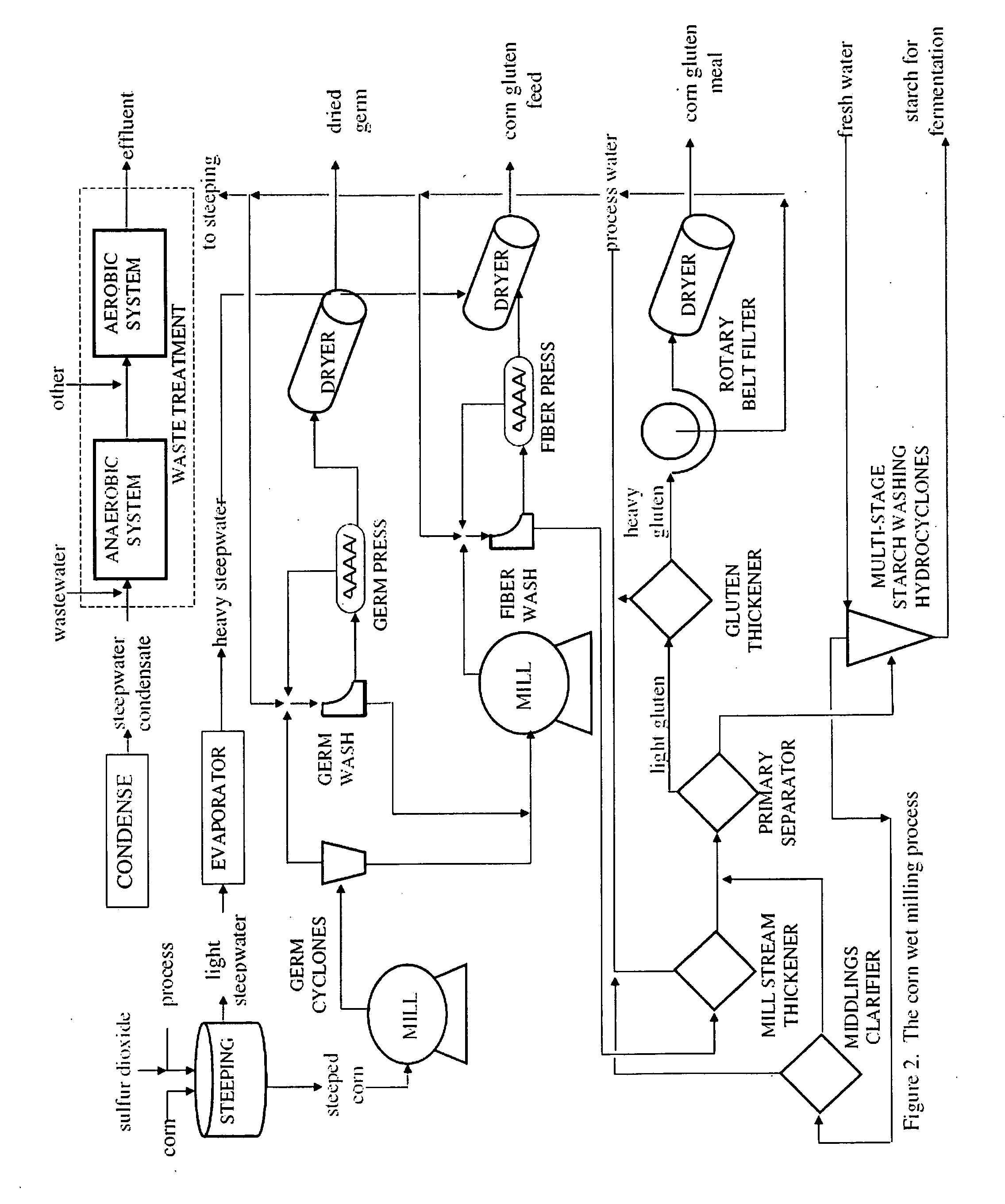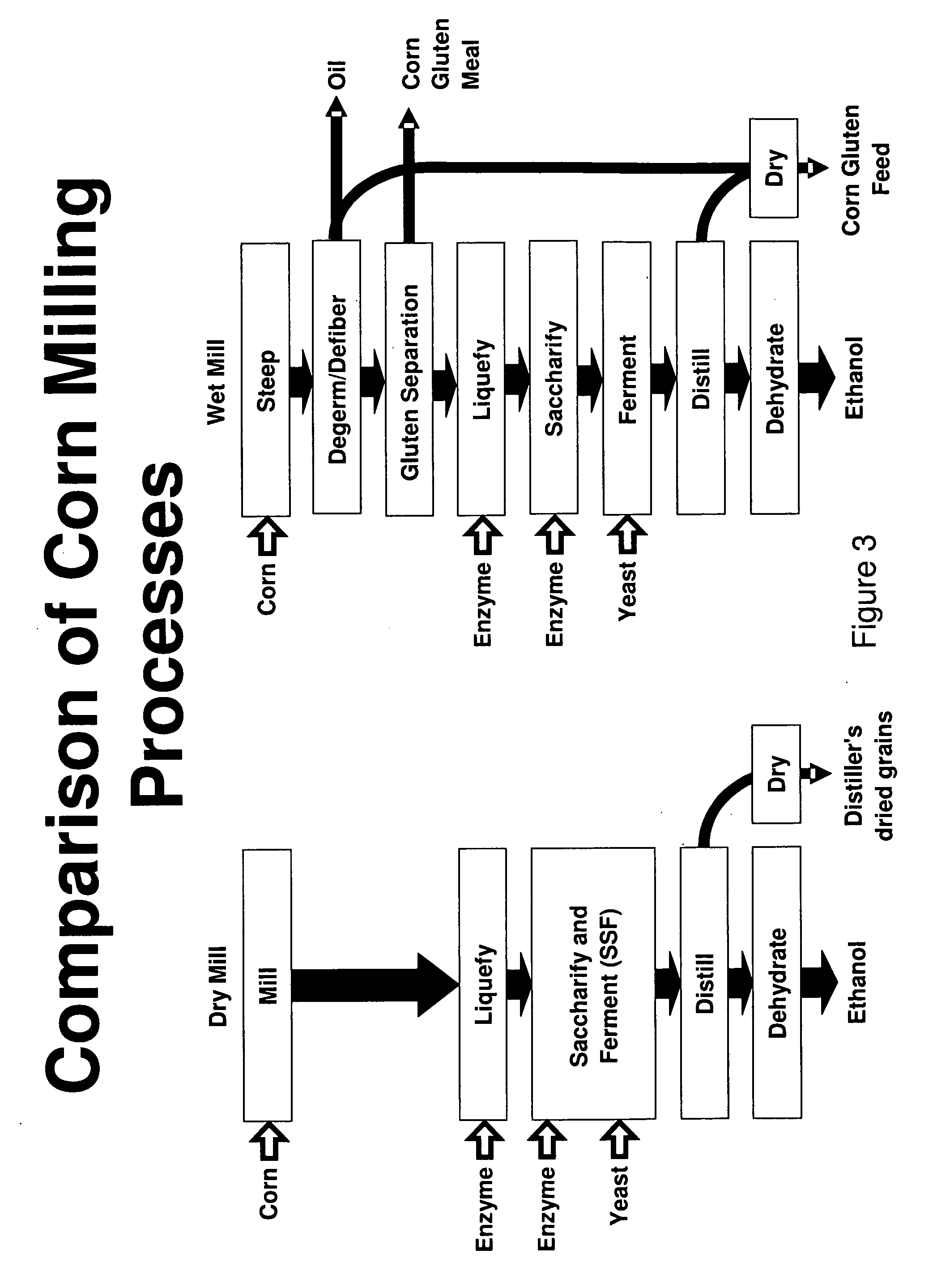Enhanced ethanol fermentation yields by removal of sugars via backset molasses
a technology of backset molasses and ethanol fermentation, which is applied in the field of ethanol fermentation, can solve the problems of reducing the yield of ethanol, limiting the use of backset recycling, and high cost of fresh water, and achieves the reduction of ethanol production costs, shortening fermentation cycles, and increasing ethanol production. the effect of production ra
- Summary
- Abstract
- Description
- Claims
- Application Information
AI Technical Summary
Benefits of technology
Problems solved by technology
Method used
Image
Examples
example 1
[0026]Example 1 reports a standard batch-fed ethanol production process, which does not use the high residual sugar fermentation method described herein and does not produce the distillers' molasses. In a typical prior art continuous wet milling ethanol fermentation, about 25 to 30% of the volume at about 45 to 50% solids is starch in a gelatinized slurry that have been treated with alpha amylase enzyme to reduce the viscosity. Backset, which is about 5% solids, is added to the corn steep liquor, which is diluted from between 7 to 11% solids to 3 to 6% solids. About 25 to 35% (by volume) of the backset produced by the fermentation is used as the diluent, with the remainder dried and added to the DDG to form DDGS.
[0027]Yeast is added to achieve an initial dose of 10-50 million viable yeast cells / ml, and the mixture is fermented for about 40 hours, resulting in less than 1 g / 100 ml of sugars. Sugars (also referred to as residual sugars) are a mixture of glucose, di-glucose molecules (...
example 2
[0029]Example 2 describes a high residual sugar ethanol production process according to one embodiment of the invention. Using a batch-fed ethanol wet mill, about 19-23% of each batch is starch in gelatinized slurry. No backset is diverted to the corn steep liquor.
[0030]The fermented mixture with the ethanol is then sent to the beer still to remove the ethanol. The residual mixture commonly known as still bottoms are then send to the decanting centrifuge to remove to produce a yeast paste and a dilute sugar solution. The yeast paste is dried on a surface drum dryer and the distillers sugars are evaporated into distiller's molasses.
example 3
[0031]Example 3 describes the application of the embodiment described in Example 2 to a modified corn dry milling ethanol process that incorporates a fiber and a germ removal step. In one process scenario, whole corn kernels are cleaned and ground and slurried in water and heated to gelatinize the starch at temperatures in the range of 60-80° C. at a pH of 5.5 or higher. Starch liquefaction can then be carried out by adding a thermostable bacterial alpha amylase and the slurry heated further to 105° C. This is followed by cooling with additional alpha added to insure that the starch is liquefied.
[0032]The pH of the liquefied starch is adjusted to a pH of about 4.5 and the slurry cooled to 60° C. Once cooled to 60° C., a fungal glucoamylase is added to saccharify the starch to a saccharification liquor that is composed primarily of glucose / maltose / higher sugars. The slurry is then centrifuged to remove the less dense germ layer and / or filtered or decanted to remove the fiber.
[0033]Th...
PUM
| Property | Measurement | Unit |
|---|---|---|
| pH | aaaaa | aaaaa |
| temperatures | aaaaa | aaaaa |
| soluble | aaaaa | aaaaa |
Abstract
Description
Claims
Application Information
 Login to View More
Login to View More - R&D
- Intellectual Property
- Life Sciences
- Materials
- Tech Scout
- Unparalleled Data Quality
- Higher Quality Content
- 60% Fewer Hallucinations
Browse by: Latest US Patents, China's latest patents, Technical Efficacy Thesaurus, Application Domain, Technology Topic, Popular Technical Reports.
© 2025 PatSnap. All rights reserved.Legal|Privacy policy|Modern Slavery Act Transparency Statement|Sitemap|About US| Contact US: help@patsnap.com



